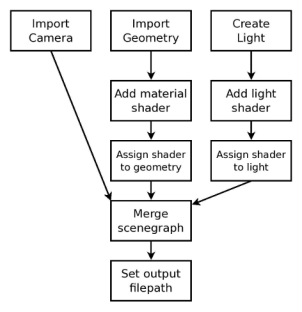What is Katana?
Katana was originally designed to solve problems with scalability and flexibility; how to carry out look development and lighting in a way that could deal with potentially unlimited amounts of scene data. It also needed to be flexible enough to deal with the requirements of modern CG Feature and VFX production for customized workflows, with the capability to edit or override anything.
Katana leverages renderers’ support for recursive procedurals, where arbitrary scene data can be created on demand. The Katana approach is to have a single procedural that is powerful enough to handle arbitrary generation and filtering. Essentially, this is a procedural given a custom program in the form of a tree-based description of filters. At render time, Katana's libraries are called from within this procedural to calculate scene data as the renderer demands.
What Can Katana Do?
Katana allows you to define what to render by using filters that can create and modify 3D scene data. A node-based interface allows users to define which filters to use, and interactively inspect their results.
Using filters you can arbitrarily create and modify scene data. You can, for example:
• Bring 3D scene data in from disk, such as from an Alembic geometry cache or camera animation data.
• Create a new instance of a material, such as a 3Delight shader.
• Create cameras and lights.
• Manipulate transforms on cameras, lights and other objects.
• Use rule based expressions to set what materials are assigned to which objects.
• Isolate parts of the scene for different render passes.
• Merge scene components from a number of partial scenes.
• Specify which AOV's you want to use for multiple passes in a single render..
• Use Python scripting to specify arbitrary manipulation of attributes at any location in the scene hierarchy.

The scene data to be delivered to the renderer is described by a tree of filters, and the filters are evaluated on demand in an iterative manner. Katana is designed to work well with renderers that are capable of deferred recursive procedurals. Using recursive procedurals, the tree of filters is handed directly to the renderer, with scene data calculated on demand, as the renderer requests it (lazy-evaluation). This is typically done by a procedural inside the renderer that uses Katana libraries, during render, to generate scene data from the filter tree.
Katana can also be used with renders that don't support procedurals or deferred evaluation, by running a process that evaluates the scene graph and writes out a scene description file for the renderer. This approach is without the benefits of deferred evaluation at render time, and the scene description file may be very large.
Note: Since Katana's filters deliver per-frame scene data in an iterable form, Katana can also be used to provide 3D scene data for processes other than renderers.
At its core, Katana is a system for the arbitrary creation, filtering, and processing of 3D scene data, with a user interface primarily designed for the needs of look development and lighting. Katana is also designed for the needs of power users, who want to create custom pipelines and manipulate 3D scene data in advanced ways.
Scene Graph Iterators
The key to the way Katana executes, filters, and delivers scene data on demand, is that scene data is only ever accessed through iterators. These iterators allow a calling process (such as a renderer) to walk the scene graph and examine any part of the data on request. Since that data can be generated as needed, a large scene graph state doesn't have to be held in memory.
In computer science terms, it is the responsibility of the calling process to maintain its own state. Katana provides a functional representation of how the scene graph should be generated, that can be statelessly lazily-evaluated.
At any location in the scene hierarchy Katana provides an iterator that can be asked:
• What named attributes there are at that location?
• What are the values for any named attribute (values are considered to be vectors of time sampled data)?
• What are the child and sibling locations (if any)?
Katana in Look Development and Lighting
Katana's scene generation and filtering are presented as a primary artist facing tool for look development and lighting by having filter functions that allow you to perform all of the classic operations carried out in look development and lighting. Primarily:
• Creating instances of shaders, or materials, out of networks of components
• Assigning shaders to objects
• Creating lights
• Moving lights
• Changing visibility flags on objects
• Defining different render passes
Katana's node-based interface provides a natural way to create recipes of which filters to use. Higher-level operations that may require a number of atomic level filters working together can be wrapped up in a single node so that the final user doesn't have to be concerned with every individual fine-grain operation. Multiple nodes can also be packaged together into single, higher-level compound nodes.
